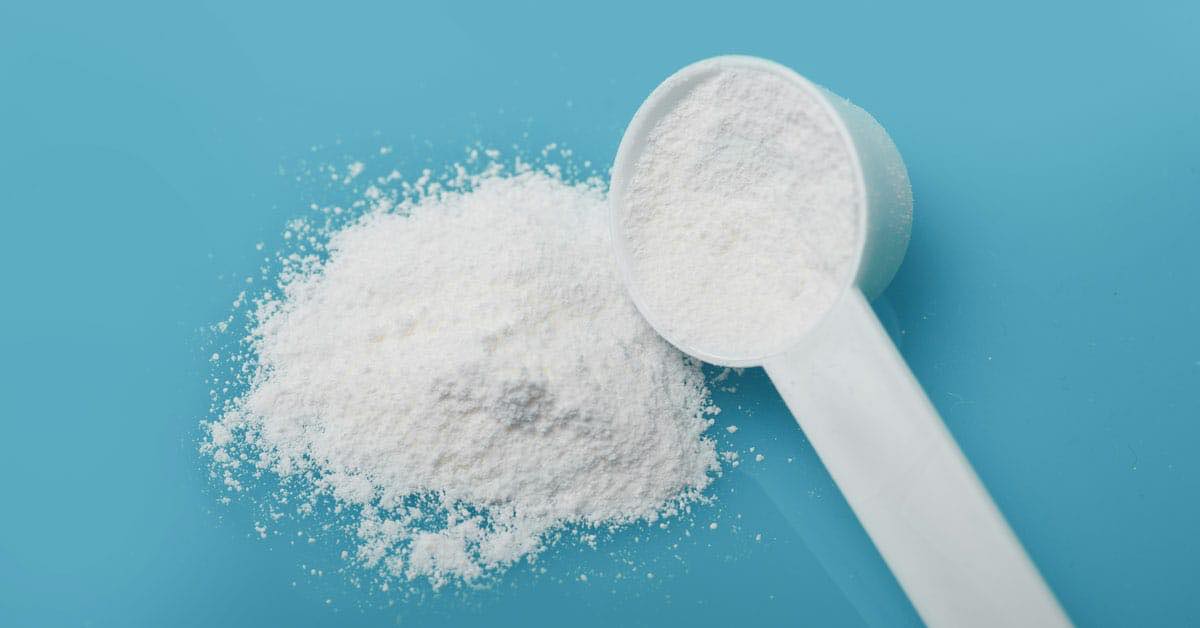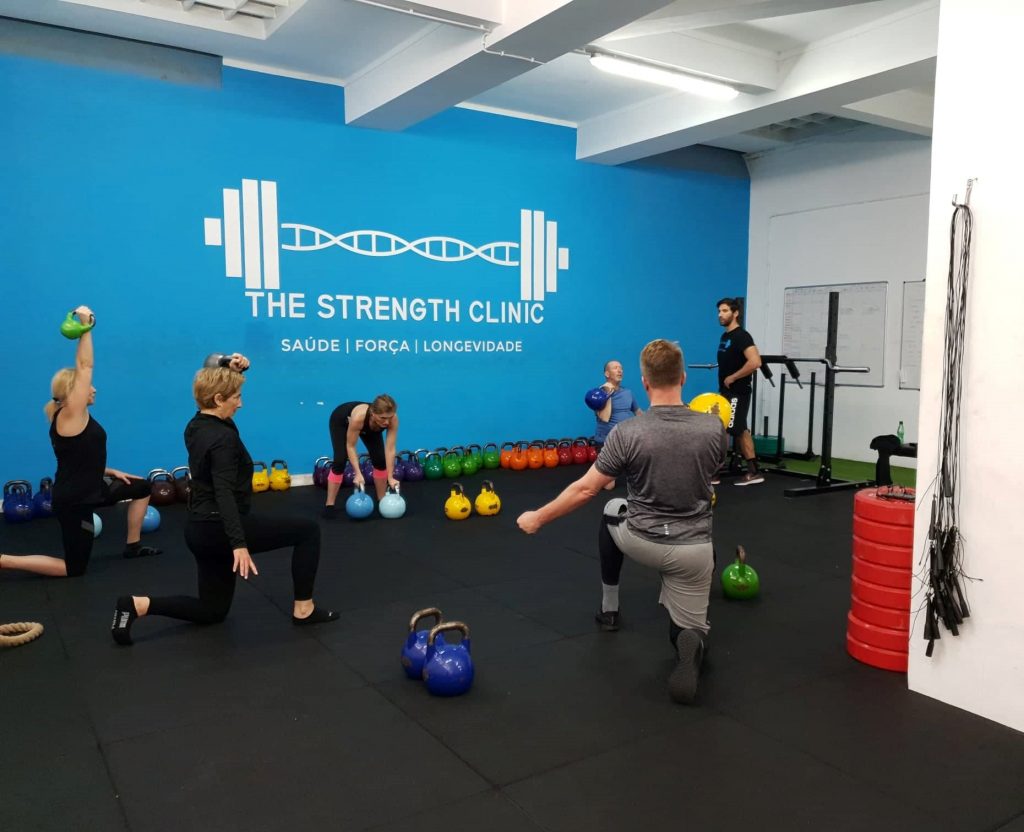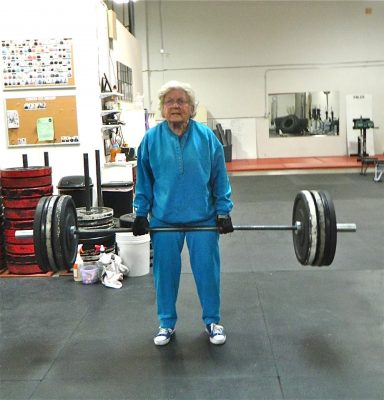The International Society of Sports Nutrition published in 2017 a position stand (see reference below) on the safety and efficacy of creatine supplementation in the context of exercise, sports and medicine.
Creatine supplementation, one of the most popular and studied nutritional supplements, has in fact been shown to be effective in improving athletic performance (especially in high intensity exercise) and inducing relevant training adaptations. The consequent increase in intramuscular creatine (and phosphocreatine) reserves facilitates the rapid re-synthesis of ATP, the so-called energy “currency” of the body, which is essential for almost every reaction in our body. Thus, the increased availability of creatine in the cell through supplementation contributes to improve performance because it increases the energy availability in order to exercise (i.e. muscle contraction) as well as a whole range of other muscle cell related reactions. Creatine supplementation can in fact enhance strength production, muscle work, accelerate recovery and help preventing injury.
Additionally, creatine supplementation appears to be highly safe and effective not only in athletes but also in non-athletes (such as the so-called exercise enthusiasts), as well as in various clinical populations. In fact, several studies (see ISSN article, reference below) point to benefits of creatine supplementation in various populations and clinical settings, such as:
– Accelerating injury rehabilitation (because it attenuates muscle atrophy);
– Protection of neuronal injuries (spinal and cerebral);
– Mitigation of debilitating consequences in people with congenital syndromes of creatine synthesis deficiency;
– Attenuating the progression of neurodegenerative diseases (e.g. Huntington’s disease, disease, Parkinson’s disease, mitochondrial diseases, amyotrophic lateral sclerosis);
– Prevention and / or improvement of bioenergetics in patients with myocardial ischemia or stroke victims;
– Improving metabolic and functional indicators associated with aging;
– Possible benefit during pregnancy for optimal growth, development and health of the fetus.
In conclusion, creatine does indeed appear to be a safe and beneficial nutritional supplement for a wide range of populations and ages. Indeed, this is a supplement that actually works!
Take creatine and power to you!
Nuno Correia
References:
Kreider, R.B. et al., 2017. International Society of Sports Nutrition position stand: safety and efficacy of creatine supplementation in exercise, sport, and medicine. Journal of the International Society of Sports Nutrition, 14(1), p.18. Available at: http://jissn.biomedcentral.com/articles/10.1186/s12970-017-0173-z.
“People don’t decide their future, people decide their habits and their habits decide their future.”
– F.M. Alexander
Nine years ago (2010)1, the European Working Group on Sarcopenia in Older People (EWGSOP) published a definition of sarcopenia that has been widely used worldwide and this definition has fostered advances in the identification and care of people at risk or with sarcopenia. It was defined as a syndrome characterized by progressive and widespread loss of muscle mass and strength at risk of adverse outcomes such as physical disability, poor quality of life and death. Because the relationship between muscle mass and strength is not linear (the ability to generate strength is not only dependent of muscle mass), the criteria for its diagnosis included low muscle mass and low muscle function (i.e. strength or physical performance).
After learning that in 2016 sarcopenia was classified as a disease by the World Health Organization, as noted in the first part of this article, the EWGSOP22 updated its operational definition and various diagnostic strategies, considering now that muscle strength (measured by grip strength or the chair stand test) is the main parameter for measuring muscle function, even more important than the amount of muscle mass. Therefore, it is in this context that we justify the title of this article and reinforce the importance of sharing this message with all health professionals.
The implications of this condition on human health are several and widely known: increased risk of falls and fractures3,4; impairment of activities of daily living5; association with heart disease6; respiratory disease7 and cognitive dysfunction8; lower quality of life9; loss of independence10,11,12 and death13. In financial terms, public health costs have also been calculated in several papers. In a study by Janssen et. al.14, in 2004, the costs of sarcopenia in the United States were estimated at $ 18.5 billion annually, representing about 1.5% of total health costs. In a study conducted here in Portugal at the Hospital de Santo António in Porto and published in 201615, it was found that hospitalization costs associated with sarcopenia were higher by 58.5% for patients under 65 years and by 34% for patients aged 65 and over. More recently (2018), the Hertfordshire Cohort Study in the United Kingdom16 found that the costs associated with lack of muscle strength were estimated at £ 2.5 billion annually.
In the present scenario, where the phenotype of unhealthy aging is proliferating in the eyes of all industrialized nations, in which diseases such as hypertension, cancer, depression, Alzheimer’s disease and type II diabetes are destroying people’s lives, it is essential to adopt measures aimed at improving function of each individual rather than diagnosing illnesses and administering medicines which, in addition, do not help solving this problem, and may further aggravate their condition. We know that the main health problems are related to poor diet, physical inactivity, lack of sleep, excess alcohol, exposure to tobacco and polluted environments but also lack of movement quality, vigor and muscular strength.
The benefits of strength training in health are well supported in the scientific literature and the most important ones are: decrease in blood pressure; decreased risk of osteoporosis and sarcopenia; improvement of lipid profile; increased cardiorespiratory capacity; prevention and management of chronic pain; increased insulin sensitivity; improvement of wellbeing and self-confidence. Moreover, several studies17,18,19 have shown a strong and consistent correlation between increased strength and muscle mass with decreased mortality, reinforcing the fact that the decline in strength associated with the current levels of sedentarism and aging need to be addressed. Therefore, a well-designed strength training program that meets the individual’s competency and follows the principles of adaptation to training will improve all of the above health indicators and all the necessary physical qualities (strength, power, speed, agility, balance, coordination, mobility, endurance) to carry out the activities of our daily life. These are the parameters of physical function that are currently being proposed as biomarkers of aging in humans20.
Consequently, program design will be the determining factor in this equation. And while it is true that this process requires imperative knowledge of sports sciences, it must be borne in mind that it also requires field work and art in coaching. Instead of being so preoccupied with following the guidelines and looking for statistically significant results, we should be concerned that our approach is relevant to one’s life. Because we work with people. People who have time constraints to train. People with different family and professional responsibilities. People who have different lives from each other. People who have a host of metabolic and / or orthopedic problems that no randomized controlled trial can ever reproduce! Yes, this is a complex process.
Finally, we know that one of the mechanisms responsible for muscle atrophy, sarcopenia and aging is apoptosis, a form of programmed cell death and a fundamental process in aging. But when we train, eat and rest properly, we are sending a signal to our body to create an anabolic environment, an environment that enhances the release of growth factors and suppresses apoptosis. That is, strength training is a macroscopic growth factor that suppresses programmed cell death (i.e. apoptosis), but unlike drugs, where an increasing in dose means more disease and dependence, an increase in load (even if reduced) means more health, more strength and more vigor. This way, the daily decisions will always be up to each one: treat the body like a Ferrari or treat the body like a rental car.
Pedro Correia
References:
- Cruz-Jentoft AJ, Baeyens JP, Bauer JM et al. Sarcopenia: European consensus on definition and diagnosis: report of the European working group on sarcopenia in older people. Age Ageing 2010; 39: 412–23.
- Cruz-Jentoft AJ, Bahat G, Bauer J, Boirie Y, Bruyère O, Cederholm T, Cooper C, Landi F, Rolland Y, Sayer AA, Schneider SM, Sieber CC, Topinkova E, Vandewoude M, Visser M, Zamboni M; Writing Group for the European Working Group on Sarcopenia in Older People 2 (EWGSOP2), and the Extended Group for EWGSOP2. Sarcopenia: revised European consensus on definition and diagnosis. Age Ageing. 2019 Jan 1;48(1):16-31.
- Bischoff-Ferrari HA, Orav JE, Kanis JA et al. Comparative performance of current definitions of sarcopenia against the prospective incidence of falls among community-dwelling seniors age 65 and older. Osteoporos Int 2015; 26:2793–802.
- Schaap LA, van Schoor NM, Lips P et al. Associations of sarcopenia definitions, and their components, with the incidence of recurrent falling and fractures: the longitudinal aging study Amsterdam. J Gerontol A Biol Sci Med Sci 2018; 73: 1199–204.
- Malmstrom TK, Miller DK, Simonsick EM et al. SARC-F: a symptom score to predict persons with sarcopenia at risk for poor functional outcomes. J Cachexia Sarcopenia Muscle 2016; 7: 28–36.
- Bahat G, Ilhan B. Sarcopenia and the cardiometabolic syndrome: a narrative review. Eur Geriatr Med 2016; 6: 220–23.
- Bone AE, Hepgul N, Kon S et al. Sarcopenia and frailty in chronic respiratory disease. Chron Respir Dis 2017; 14: 85–99.
- Chang KV, Hsu TH, Wu WT et al. Association between sarcopenia and cognitive impairment: a systematic review and metaanalysis. J Am Med Dir Assoc 2016; 17: 1164.e7–64.e15.
- Beaudart C, Biver E, Reginster JY et al. Validation of the SarQoL(R), a specific health-related quality of life questionnaire for Sarcopenia. J Cachexia Sarcopenia Muscle 2017; 8: 238–44.
- Dos Santos L, Cyrino ES, Antunes M et al. Sarcopenia and physical independence in older adults: the independent and synergic role of muscle mass and muscle function. J Cachexia Sarcopenia Muscle 2017; 8: 245–50.
- Akune T, Muraki S, Oka H et al. Incidence of certified need of care in the long-term care insurance system and its risk factors in the elderly of Japanese population-based cohorts: the ROAD study. Geriatr Gerontol Int 2014; 14: 695–701.
- Steffl M, Bohannon RW, Sontakova L et al. Relationship between sarcopenia and physical activity in older people: a systematic review and meta-analysis. Clin Interv Aging 2017; 12: 835–45.
- De Buyser SL, Petrovic M, Taes YE et al. Validation of the FNIH sarcopenia criteria and SOF frailty index as predictors of long-term mortality in ambulatory older men. Age Ageing 2016; 45: 602–8.
- Janssen I, Shepard DS, Katzmarzyk PT, Roubenoff R. The healthcare costs of sarcopenia in the United States. J Am Geriatr Soc. 2004 Jan;52(1):80-5.
- Sousa AS, Guerra RS, Fonseca I, Pichel F, Ferreira S, Amaral TF. Financial impact of sarcopenia on hospitalization costs. Eur J Clin Nutr. 2016 Sep;70(9):1046-51. doi: 10.1038/ejcn.2016.73. Epub 2016 May 11.
- Pinedo Villanueva, R. A., Westbury, L. D., Syddall, H. E., Sanchez, M., Dennison, E. M., Robinson, S. M., & Cooper, C. (2018). Health care costs associated with muscle weakness: a UK population-based estimate. Calcified Tissue International.
- Ruiz JR, Sui X, Lobelo F, et al. Association between muscular strength and mortality in men: prospective cohort study. BMJ. 2008;337(7661):a439. Published. doi:10.1136/bmj.a439.
- Srikanthan P, Karlamangla AS. Muscle mass index as a predictor of longevity in older adults. Am J Med. 2014;127(6):547-53.
- Dos Santos L, Cyrino ES, Antunes M, Santos DA, Sardinha LB. Changes in phase angle and body composition induced by resistance training in older women. Eur J Clin Nutr. 2016 Dec;70(12):1408-1413. doi: 10.1038/ejcn.2016.124. Epub 2016 Jul 13. PubMed PMID: 27406159.
- Cadore EL, Izquierdo M. Muscle Power Training: A Hallmark for Muscle Function Retaining in Frail Clinical Setting. J Am Med Dir Assoc. 2018 Mar;19(3):190-192.
If your grandfather is a normal person, it is very likely that he has been to the doctor many times, that he is on medication, that he does not hear very well and that he does not have the same locomotion capacity and reasoning that he had some years ago.
Doctors say this is “normal” and typical of the advancing age. They also prescribe drugs based on the belief that this will improve the quality of life of these people. I do not say that this is not necessary in some cases, but I do not believe that this is the best approach to increase health span. Although they “breathe” I think that they deserve better and more.
More than two years ago, a piece in a portuguese newspaper stated that the Portuguese lived longer and longer but less healthy. The piece also mentioned: “Portuguese women have one of the longest life expectancy in the world, but, paradoxically, enjoy far fewer healthy years than women from the best-ranked countries in Europe.”
When reading the piece, the first thing I thought was: we have to be really stupid, because even with the daily advances of medicine and scientific knowledge, we have not yet been able to understand what are the causes behind this SICK LONGEVITY. The problem is not the advancing years, the problem lies in nutrition and exercise related advice we hear every day (especially in hospitals), which is simply erroneous. If prevention campaigns and the information leaflets in hospitals were really supported by scientific evidence, one would not witness so many people suffering from chronic pain, diabetes, heart disease, osteoporosis, sarcopenia, autoimmune diseases and cancer.
Everyone recognizes that physical exercise is key to optimal body function (our brain and body did not develop while sitting on our asses), and that, unlike drugs, has a positive and self-regulating impact on the various systems of the human body.
Exercising is more effective on improving your health than any patented medicine.
“But I walk an hour every day”
Let me tell you one thing, walking is the least you can do to keep your body working. If you tell me that is either walking or lying back on the couch eating ice cream, then you better walk. But if you tell me that you want to live a healthy life until you die, maintain your autonomy, decrease the risk of falls, increase self-confidence, sleep better, recover faster from an injury and not be part of the statistics we saw above, then I recommend you start seriously thinking about lifting weights and engaging in strength training. Walking will not give you, even by shadows, the same benefits as strength training.
Another thing, if you are one of those people with cardiovascular disease, your doctor (or some Dr. from Google) has probably told you that walking is important to improve your cardiovascular health. The problem is that walking will not help you much. The lack of aerobic capacity is not a risk factor for heart disease, a sedentary lifestyle is! This means that you may have a huge aerobic capacity and a heart disease at the same time. In fact, according to this study published in the 2006 American Heart Association Journal (LINK), to this one published in 2008 in the European Heart Journal (LINK) and to this one published in the Mayo Clinic Proceedings (LINK) in 2012, marathoners are those who appear to be at increased risk of developing cardiovascular disease.
Furthermore, according to the cardiologist Henry A. Solomon in the book “The Exercise Myth”, cardiovascular health refers to the absence of heart and blood vessel disease, and not to an individual’s ability to do a certain amount of physical work. According to Dr. Solomon, your cardiac health is determined by the condition of various structures of the heart, including the heart muscle, the valves, the special cardiac tissues that carry electrical impulses and the coronary arteries. So, do not expect exercise to “clean” what you practice in your daily diet.
The cardio craze came about in the late 60’s / early 70’s through Dr. Kenneth Cooper, the person who designed the Cooper test for US military use. It was roughly from this moment on that VO2max (a measure of aerobic capacity) was “elected” the holy grail of physical fitness. Although relevant for performance and longevity, VO2max is not the only marker of physical fitness. Strength in its various forms has been more strongly correlated with increased longevity than VO2max. While strength training can increase both functional strength and aerobic capacity, the typical cardio training will not make you stronger and will only slightly “at best” increase your VO2max.
Why Strength Training?
Because you tend to lose strength and power as you age, and because several studies have shown that loss of strength and muscle mass are associated with increased mortality (LINK, LINK, LINK). Fortunately, lifting weights is the best stimulus to counteract this trend and to increase our functional capacity. Under normal conditions, strength peaks between the ages of 20 and 30, remaining relatively stable or decreasing slightly over the following 20 years. But this is dependent, of course, of what one does in training.
It is in the sixth decade of life that decreases in strength are quite pronounced. According to several longitudinal studies, declines in muscle strength are around 15% between 60-70 years of age and 30% after age 70. Most reasons relate to the loss of muscle mass, pronounced loss of fast-twitch muscle fibers, decreased endocrine function, loss of tissue mobility / elasticity and cell dehydration. All of these can be minimized by following a proper strength training program.
Yes, it is possible to start strength training at any age, I know people who started training at 50, 60 and over 80, it’s all a matter of mindset and willpower. Also, you need to train according to your needs as opposed to the convenience of most gyms (i.e. spending hours on the treadmill / elliptical / bike, going through all the machines and ignore training with free weights) where supervision, tutoring and skill learning are dismissed.
Does this mean that I should get my grandparents to lift Olympic bars and weights without any criteria? Of course not, that would not be very smart. To get the most benefit of lifting weights you have to walk a path and create a solid movement base. You have to be screened and assessed for movement quality and physical parameters. Preferably guided by a fitness professional or personal trainer knowledgeable in movement and strength training science.
Listen, your doctor’s opinion might be highly valuable, however remember the following: 1) your doctor is not a specialist in movement (which is ok, they can not be trained in everything); 2) your doctor has no experience training people (which is also ok, it’s not their job); 3) your doctor probably does not even know how to lift weights or to move well (this is obviously not ok!). In other words, just as you would not ask advice on surgery techniques from strength coaches, you should also not ask advice on training methodologies and forms of physical exercise from surgeons.
Oh, and before you tell me that I’m being fundamentalist and suggesting that you should not train other physical abilities (such as stability, mobility, endurance, speed, agility, motor coordination, power), allow me to conclude with the following observation: ideally, the training program of any human being on the planet should always be the one that induces the adaptations necessary to fulfill his /her personal goals.
The key word here is adaptation! The more adapted you are the better prepared you will be to face any situation. Adults are free to do whatever they want in life. Everyday we make decisions and choices and those decisions matter. My goal is to increase longevity and live until the last days of my life feeling great and strong.
What’s yours?
See you soon!
Pedro Correia
References
Möhlenkamp S, Lehmann N, Breuckmann F, Bröcker-Preuss M, Nassenstein K, Halle M, Budde T, Mann K, Barkhausen J, Heusch G, Jöckel KH, Erbel R; Marathon Study Investigators; Heinz Nixdorf Recall Study Investigators. Running: the risk of coronary events : Prevalence and prognostic relevance of coronary atherosclerosis in marathon runners. Eur Heart J. 2008 Aug;29(15):1903-10. doi: 10.1093/eurheartj/ehn163. Epub 2008 Apr 21.
Neilan TG1, Januzzi JL, Lee-Lewandrowski E, Ton-Nu TT, Yoerger DM, Jassal DS, Lewandrowski KB, Siegel AJ, Marshall JE, Douglas PS, Lawlor D, Picard MH, Wood MJ. Myocardial injury and ventricular dysfunction related to training levels among nonelite participants in the Boston marathon. Circulation. 2006 Nov 28;114(22): 2325-33. Epub 2006 Nov 13.
O’Keefe JH, Patil HR, Lavie CJ, Magalski A, Vogel RA, McCullough PA. Potential adverse cardiovascular effects from excessive endurance exercise. Mayo Clin Proc. 2012 Jun;87(6):587-95. doi: 10.1016/j.mayocp.2012.04.005.
Rantanen T, Harris T, Leveille SG, Visser M, Foley D, Masaki K, Guralnik JM. Muscle strength and body mass index as long-term predictors of mortality in initially healthy men. J Gerontol A Biol Sci Med Sci. 2000 Mar;55(3):M168-73.
Ruiz JR, Sui X, Lobelo F, Morrow JR Jr, Jackson AW, Sjöström M, Blair SN. Association between muscular strength and mortality in men: prospective cohort study. BMJ. 2008 Jul 1;337:a439. doi: 10.1136/bmj.a439.
Takata Y, Ansai T, Soh I, Akifusa S, Sonoki K, Fujisawa K, Awano S, Kagiyama S, Hamasaki T, Nakamichi I, Yoshida A, Takehara T. Association between body mass index and mortality in an 80-year-old population. J Am Geriatr Soc. 2007 Jun;55(6):913-7.
Zatsiorsky V., Kraemer, W. Science and Practice of Strength Training 2nd Edition.
Human Kinetics (2006).



